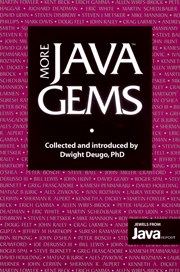Book contents
- Frontmatter
- Contents
- INTRODUCTION
- GETTING STARTED WITH JAVA
- MIGRATING TO JAVA
- TECHNIQUES 101
- MODELING AND PATTERNS
- JAVA IN A DISTRIBUTED WORLD
- THREADS
- USER INTERFACES
- SECURITY
- TESTING
- EFFECTIVE TEST STRATEGIES FOR ENTERPRISE-CRITICAL APPLICATIONS
- PUTTING JAVABEANS TO THE TEST
- TEST-INFECTED: PROGRAMMERS LOVE WRITING TESTS
- PERFORMANCE
- REALITY CHECK
- INDEX
EFFECTIVE TEST STRATEGIES FOR ENTERPRISE-CRITICAL APPLICATIONS
Published online by Cambridge University Press: 06 July 2010
- Frontmatter
- Contents
- INTRODUCTION
- GETTING STARTED WITH JAVA
- MIGRATING TO JAVA
- TECHNIQUES 101
- MODELING AND PATTERNS
- JAVA IN A DISTRIBUTED WORLD
- THREADS
- USER INTERFACES
- SECURITY
- TESTING
- EFFECTIVE TEST STRATEGIES FOR ENTERPRISE-CRITICAL APPLICATIONS
- PUTTING JAVABEANS TO THE TEST
- TEST-INFECTED: PROGRAMMERS LOVE WRITING TESTS
- PERFORMANCE
- REALITY CHECK
- INDEX
Summary
Java has quickly evolved into more than a simple-minded language used to create cute animations on the Web. These days, a large number of serious Java developers are building enterprise-critical applications that are being deployed by large companies around the world. Some applications currently being developed on the Java platform range from traditional Spreadsheets and Word Processors to Accounting, Human Resources, and Financial Planning applications. Because these applications are complex and use rapidly evolving Java technology, companies need to employ a vigorous quality assurance program to produce a high-quality and reliable product. Quality assurance and test teams must get involved early in the product development life cycle, creating a sound test plan, and applying an effective test strategy to insure that these enterprise-critical applications provide accurate results and are defect-free. Accuracy is critical for users who apply these results to crucial decisions about their business, their finances, and their enterprise. I present a case-study of how an effective testing strategy, focused on sub-system level automation, was applied to successfully test a critical real-world Java-based financial application.
THE APPLICATION
The application is being developed by a leading financial services company (hereafter referred to as client) and is targeted toward both individual investors and institutional investors, particularly those investors that are interested in managing their finances and retirement plans. Reliable Software Technologies (RST) provided the QA/Test services and the test team (hereafter referred to as the QA/Test team) to the client.
- Type
- Chapter
- Information
- More Java Gems , pp. 339 - 350Publisher: Cambridge University PressPrint publication year: 2000

